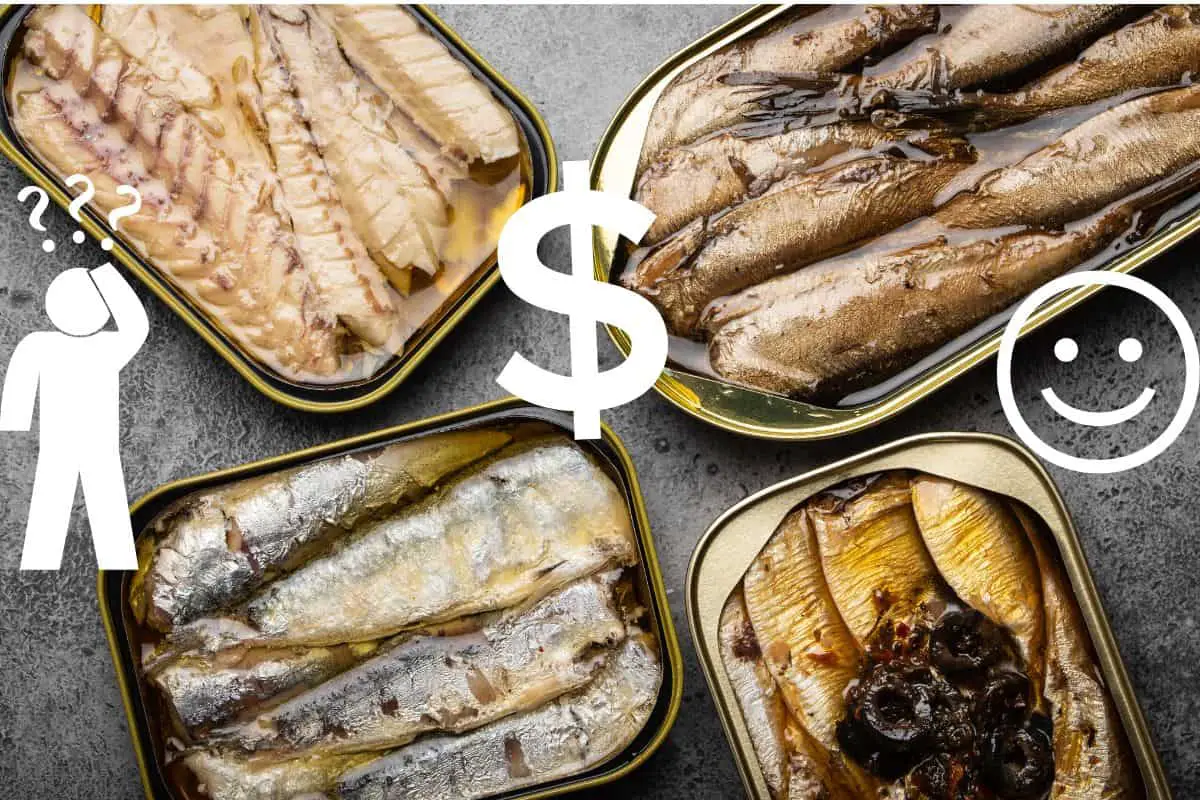Looking for the best deals on canned fish without sacrificing taste or quality? You’re in the right place!
The cheapest canned fish options are typically mackerel, sardines, and tuna, while salmon, anchovies, herring, cod, and Riga sprats can be pricier. Buying in bulk and comparing prices of fish in various oils, water, and sauces can also help save money.
Why Choose Canned Fish?
Affordable and Nutritious
Canned fish is a budget-friendly source of high-quality protein, omega-3 fatty acids, vitamins, and minerals. It’s also convenient, having a long shelf life and being ready to eat or cook with minimal preparation.
Sustainable Options
Many canned fish options, like sardines and mackerel, are more sustainable compared to other seafood choices. Look for eco-labels such as Marine Stewardship Council (MSC) certification to ensure your canned fish is sustainably sourced.
Comparing the Cheapest Canned Fish Options: An In-Depth Look
In this section, we’ll take a closer look at the cheapest canned fish options and their unique characteristics, nutritional benefits, and various uses in recipes. To help you choose the best canned fish for your needs and budget, we’ve prepared a comprehensive comparison table below, detailing the price range, nutritional benefits, packaging mediums, and recipe uses for various canned fish options.
| Canned Fish | Price Range | Nutritional Benefits | Common Packaging Mediums | Common Uses in Recipes |
|---|---|---|---|---|
| Mackerel | $ | Omega-3 fatty acids, vitamin B12, selenium | Oil, water, tomato sauce | Salads, sandwiches, pasta |
| Sardines | $ | Omega-3 fatty acids, calcium, vitamin D, protein | Oil, water, mustard sauce, tomato sauce | Salads, pizza toppings, pasta |
| Tuna | $ | Protein, omega-3 fatty acids, vitamins, minerals | Oil, water | Sandwiches, wraps, casseroles, sushi |
| Salmon | $$ | Omega-3 fatty acids, vitamin D, protein | Oil, water | Salads, sandwiches, pasta |
| Anchovies | $$ | Omega-3 fatty acids, calcium, iron | Oil, salt | Caesar salad, pizza, pasta, tapenade |
| Herring | $$ | Omega-3 fatty acids, vitamin D, vitamin B12 | Oil, water, wine sauce, mustard sauce | Salads, sandwiches, spreads, crackers |
| Cod | $$ | Protein, vitamin B12, selenium | - | Fish cakes, chowders, fish tacos, sandwiches |
| Riga Sprats | $$ | Omega-3 fatty acids, calcium, vitamin D | Oil, tomato sauce | Appetizers, salads, sandwiches |
Mackerel
Mackerel is an affordable and nutritious option for those seeking budget-friendly canned fish. It’s rich in omega-3 fatty acids, vitamin B12, and selenium, making it an excellent addition to a healthy diet.
Mackerel has a strong, distinctive flavor and is commonly available canned in oil, water, or tomato sauce. Each medium has its own benefits:
- Oil: Provides a richer flavor and smoother texture, but may add extra calories and fat.
- Water: Offers a healthier alternative with fewer calories and less fat, but may result in a slightly drier texture.
- Tomato sauce: Adds a tangy, savory flavor that pairs well with the fish’s natural taste.
Mackerel can be enjoyed straight from the can or used in various dishes, such as salads, sandwiches, and pasta.
Sardines
Sardines are another budget-friendly canned fish option that provides a wealth of nutritional benefits. They’re an excellent source of omega-3 fatty acids, calcium, vitamin D, and protein. These small, oily fish have a soft texture and mild flavor that’s widely enjoyed.
You can find sardines canned in various mediums, including oil, water, mustard sauce, or tomato sauce. Each offers its unique taste and texture:
- Oil: Enhances the flavor and texture of the fish while adding extra calories and fat.
- Water: A healthier alternative with fewer calories and less fat, but may result in a slightly drier texture.
- Mustard sauce: Offers a tangy, slightly spicy flavor that complements the fish.
- Tomato sauce: Provides a savory, tomato-based flavor that works well with the mild taste of sardines.
Sardines can be enjoyed on their own, mixed into salads, or used as a topping for pizza and pasta.
Tuna
Tuna is a popular, low-cost canned fish that comes in various types, such as skipjack, albacore, and yellowfin. It’s available canned in oil or water, with the former providing a richer flavor and the latter being a healthier option with fewer calories and less fat.
Tuna is a good source of protein, omega-3 fatty acids, and several vitamins and minerals. However, it’s essential to be mindful of the potential for higher mercury levels in some tuna species. To minimize exposure, opt for smaller species like skipjack or light tuna, which typically contain lower mercury levels.
Tuna can be used in a wide range of recipes, from sandwiches and wraps to casseroles and sushi.
Other Canned Fish to Consider
Salmon
While salmon is more expensive than mackerel or sardines, it remains an affordable canned fish option. It’s a fantastic source of omega-3 fatty acids, vitamin D, and protein. Salmon is available canned in oil or water. Oil-canned salmon offers a richer taste, while water-canned salmon provides a healthier alternative with fewer calories and less fat.
Salmon can be used in various dishes, such as salads, sandwiches, and pasta, or enjoyed on its own as a nutritious snack.
Anchovies
Anchovies are small, oily fish that can be more expensive than other canned fish options. They have a strong, salty flavor and are often sold in oil or salt. Anchovies are rich in omega-3 fatty acids, calcium, and iron.
These tiny fish are commonly used as a flavor enhancer in various dishes, such as Caesar salad, pizza, pasta, and tapenade. Due to their potent flavor, they’re typically used sparingly to add a burst of umami and depth to recipes.
Herring
Herring is another pricier canned fish option but is well worth considering for its nutritional benefits and versatility. It’s rich in omega-3 fatty acids, vitamin D, and vitamin B12. Herring can be found canned in oil, water, or various sauces, such as wine or mustard sauce.
Herring has a mild flavor and tender texture, making it an enjoyable addition to various dishes. It can be used in salads, sandwiches, and spreads, or enjoyed on its own with crackers.
Cod
Canned cod is a lean, white fish with a mild flavor and delicate texture. It can be more expensive than other canned fish options but is an excellent source of protein, vitamin B12, and selenium.
Cod can be enjoyed in various dishes, such as fish cakes, chowders, and fish tacos, or simply mixed with mayonnaise and seasonings for a delicious sandwich filling.
Riga Sprats
Riga sprats are small, oily fish that are typically more expensive than other canned fish options. They’re often canned in oil or tomato sauce and are a good source of omega-3 fatty acids, calcium, and vitamin D.
These Baltic fish have a unique, smoky flavor that makes them a tasty addition to appetizers, salads, or sandwiches. They can also be enjoyed on their own, straight from the can.
Choosing the Best Canned Fish for Your Needs
When selecting the cheapest canned fish for your needs, it’s important to weigh the costs against factors such as flavor, texture, and nutritional content. Mackerel, sardines, and tuna are some of the most budget-friendly options, while salmon, anchovies, herring, cod, and Riga sprats offer unique flavors and health benefits at a slightly higher price point.
Consider your personal preferences and dietary needs when making your choice. You may also wish to explore canned fish in various mediums, such as oil, water, or sauces, to find the best combination of taste, texture, and healthfulness.
By being informed about the various canned fish options available, you can make the most of your budget while enjoying delicious and nutritious meals.
Comparing Fish in Different Oils, Water, and Sauces
As the popularity of canned fish continues to grow, consumers are often faced with the challenge of choosing between these diverse options. While taste and health considerations are essential factors, it’s equally important to consider the impact of these choices on our wallet.
Canned fish packed in oil, typically olive or sunflower oil, is a popular choice among consumers who appreciate its rich, full-bodied flavor. However, this option tends to be slightly more expensive than its counterparts due to the cost of the oil itself. While the price difference may not be significant when purchasing a single can, it can add up over time, particularly for those who consume canned fish regularly.
On the other hand, canned fish in water offers a lighter, more natural taste and is often more affordable than oil-packed varieties. This option is particularly appealing to health-conscious consumers looking to reduce their fat intake without sacrificing convenience. Moreover, the lower cost of water-packed canned fish allows you to enjoy this nutritious protein source more frequently without breaking the bank.
Lastly, canned fish in sauces such as tomato or mustard provides a unique, flavorful twist on this classic pantry staple. While these options may be slightly pricier than water-packed fish, they often deliver a delicious taste experience that’s well worth the extra cost. The added flavor from the sauce can also help to elevate a simple meal, providing additional value beyond the price tag.
Is It Cheaper to Buy Canned Fish in Bulk?
Buying canned fish in bulk can often result in significant savings, especially if you’re a frequent consumer. Look for bulk discounts at your local grocery store, warehouse club, or online retailers. Just be sure to check the expiration dates and ensure you have sufficient storage space before making a large purchase.
Tips for Buying and Storing Canned Fish
Expiration Dates
Canned fish has a long shelf life, typically ranging from 2 to 5 years. However, it’s still important to check the expiration dates when purchasing and rotate your stock to consume older cans first.
Store in a Cool, Dry Place
To maintain the quality of your canned fish, store it in a cool, dry place away from direct sunlight or heat sources. Ideal storage temperatures are between 10-21°C (50-70°F).
Inspect Cans for Damage
Before purchasing or consuming canned fish, inspect the cans for any signs of damage, such as dents, bulging, or rust. Damaged cans can compromise the safety and quality of the contents.
Is Canned Fish Cheaper Than Fresh?
When comparing the costs of canned, fresh, and frozen fish, canned fish is often the most affordable option. Fresh fish can be expensive, especially when it comes to popular varieties like salmon and cod. The price of fresh fish depends on factors like seasonality, availability, and transportation costs. However, buying fresh fish can be a good investment if you prioritize taste and texture, or if you’re seeking specific fish types that are not commonly available in canned form.
Is Canned Fish Cheaper Than Frozen?
Canned fish is generally cheaper than frozen fish, although prices can vary depending on the type of fish and the brand. Frozen fish offers some benefits over canned fish, such as better texture and a milder flavor. It can also be a more cost-effective option for those who prefer to cook larger quantities of fish at once, as it can be purchased in bulk and stored in the freezer for extended periods.
In summary, canned fish is typically the most budget-friendly option when compared to fresh and frozen fish. However, each option offers its unique advantages in terms of taste, texture, and convenience. Ultimately, the best choice will depend on your individual preferences, budget, and cooking needs.
Final Thoughts
In summary, the cheapest canned fish options include mackerel, sardines, and tuna. Consider buying in bulk and comparing prices of fish canned in various oils, water, and sauces to find the best deals. Keep in mind that some pricier options, like salmon, anchovies, herring, cod, and Riga sprats, can still be affordable and offer unique flavors and nutritional benefits. By following these tips and making informed choices, you can enjoy delicious, nutritious, and budget-friendly canned fish meals.

